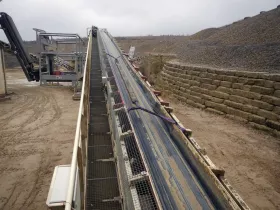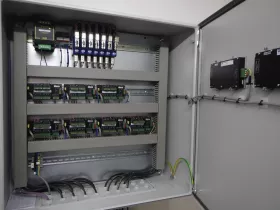
Belt conveyors just belong to the production plants of the pit and quarry industry. They are inevitable for the material transport from the pre-crusher to the processing plant, for conveying the fractions to the material dump or for truck loading. Belt conveyors handle the transport reliably and effectively.
Therefore, the increasingly important information about the throughput on belt conveyors should be measured accurately and continuously with a scale: This was also perceived and implemented in a natural stone working site in Germany. Here, natural stone is extracted and processed for a variety of applications, such as the construction of walls or for mineral mixtures.
In this case belt scales are the optimal weighing solution, because they can be retrofitted into existing belt conveyors. Seven stationary belt conveyors were equipped with built-in belt scales by MTS. The weighings are for process monitoring or internal inventory of the flow rates and are able to achieve exact accuracies of less than 2% measuring error.
The dolomite brick is transported via belt conveyors from stationary crusher plants to several bunkers. Then the material is loaded into trucks by wheel loaders. Depending on the desired grain size of the dolomite, several crushing plants are to be passed. All crushing plants are connected with conveyor belts. One crusher feeds several conveyors belts.

Due to the low belt widths and flow rates, six belt conveyors were equipped with the new ESW 2.2 belt scale. This type of belt scale can be used especially in belt conveyors with belt widths from 400 mm and flow rates from 2 t/h. The ESW 2.2 fea- tures a compact design and high frame stiffness. The special design allows a quicker access to the load cells — this saves time and effort in case of maintenance and repairing.
Another conveyor was equipped with the single-idler belt scale EBW 10-HD, which is designed with a strengthened frame unit for larger belt widths and higher flow rates.
The installation of the belt scales was more difficult because of the special belt construction with many stiffeners. Therefore, the belt strip had to be removed in the area of the weighing platform. Angle irons for fixing of the belt scales and belt stiffeners must be welded. Existing idlers could be easily converted into measurement idlers.

The evaluation of the seven belt scales is made by the control unit ModWeigh FBW and combined in a housing. Additionally the control unit has two operating and display modules so that the evaluation can be carried out in two groups of four or three belt scales. This simplifies the handling during service and start-ups. The connection to the process control system is realized by Profibus. As a result the in- formation about the absolute quantity, the current flow rate in t/h and a lot of measuring signals are available for the plant operator.
When commissioning the belt scales, a zero calibration was done for all scales. Due to local conditions three belt scales could not be adjusted by material test. In this case, the MTS test chain was used simulating the material load on the scale.
Conclusion
Built-in belt scales in belt conveyors are an important tool for process monitoring in many companies. Thereby the operation of production plant is effective and rewarding.
The integration of the measured data in the process control system generates a much higher transparency during the storage of the stones. The plant availability increases, capacities can be handled more flexibly and easily.
■







